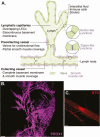Crosstalk Between Adipose and Lymphatics in Health and Disease
- PMID: 34718498
- PMCID: PMC8599804
- DOI: 10.1210/endocr/bqab224
Crosstalk Between Adipose and Lymphatics in Health and Disease
Abstract
Adipose tissue, once thought to be an inert receptacle for energy storage, is now recognized as a complex tissue with multiple resident cell populations that actively collaborate in response to diverse local and systemic metabolic, thermal, and inflammatory signals. A key participant in adipose tissue homeostasis that has only recently captured broad scientific attention is the lymphatic vasculature. The lymphatic system's role in lipid trafficking and mediating inflammation makes it a natural partner in regulating adipose tissue, and evidence supporting a bidirectional relationship between lymphatics and adipose tissue has accumulated in recent years. Obesity is now understood to impair lymphatic function, whereas altered lymphatic function results in aberrant adipose tissue deposition, though the molecular mechanisms governing these phenomena have yet to be fully elucidated. We will review our current understanding of the relationship between adipose tissue and the lymphatic system here, focusing on known mechanisms of lymphatic-adipose crosstalk.
Keywords: adipose tissue; lipedema; lymphatic endothelium; lymphedema; obesity.
© The Author(s) 2021. Published by Oxford University Press on behalf of the Endocrine Society. All rights reserved. For permissions, please e-mail: journals.permissions@oup.com.
Figures



Similar articles
-
The Lymphatic Vasculature: Its Role in Adipose Metabolism and Obesity.Cell Metab. 2017 Oct 3;26(4):598-609. doi: 10.1016/j.cmet.2017.07.020. Epub 2017 Aug 24. Cell Metab. 2017. PMID: 28844882 Free PMC article. Review.
-
Regulation of lymphatic function and injury by nitrosative stress in obese mice.Mol Metab. 2020 Dec;42:101081. doi: 10.1016/j.molmet.2020.101081. Epub 2020 Sep 14. Mol Metab. 2020. PMID: 32941994 Free PMC article.
-
The link between lymphatic function and adipose biology.Ann N Y Acad Sci. 2008;1131:82-8. doi: 10.1196/annals.1413.007. Ann N Y Acad Sci. 2008. PMID: 18519961 Review.
-
Vascular Endothelial Growth Factor-D (VEGF-D) Overexpression and Lymphatic Expansion in Murine Adipose Tissue Improves Metabolism in Obesity.Am J Pathol. 2019 Apr;189(4):924-939. doi: 10.1016/j.ajpath.2018.12.008. Epub 2019 Mar 13. Am J Pathol. 2019. PMID: 30878136 Free PMC article.
-
A closer look at adipose tissue lymphatics and their markers.Curr Opin Hematol. 2022 May 1;29(3):144-150. doi: 10.1097/MOH.0000000000000712. Epub 2022 Feb 25. Curr Opin Hematol. 2022. PMID: 35220323 Review.
Cited by
-
The Anti-Diabetic Potential of Baicalin: Evidence from Rodent Studies.Int J Mol Sci. 2023 Dec 28;25(1):431. doi: 10.3390/ijms25010431. Int J Mol Sci. 2023. PMID: 38203600 Free PMC article. Review.
-
KATP channels in lymphatic function.Am J Physiol Cell Physiol. 2022 Oct 1;323(4):C1018-C1035. doi: 10.1152/ajpcell.00137.2022. Epub 2022 Jul 4. Am J Physiol Cell Physiol. 2022. PMID: 35785984 Free PMC article. Review.
References
-
- Zhang Y, Proenca R, Maffei M, Barone M, Leopold L, Friedman JM. Positional cloning of the mouse obese gene and its human homologue. Nature. 1994;372(6505):425-432. - PubMed
-
- Eriksson G. Olaus Rudbeck as scientist and professor of medicine. Sven Med Tidskr. 2004;8(1):39-44. - PubMed
-
- Ambrose CT. The priority dispute over the function of the lymphatic system and Glisson’s ghost (the 18th-century Hunter–Monro Feud). Cell Immunol. 2007;245(1):7-15. - PubMed
-
- de Bree E, Tsiaoussis J, Schoretsanitis G. The history of lymphatic anatomy and the contribution of Frederik Ruysch. Hell J Surg. 2018;90(6):308–314.

